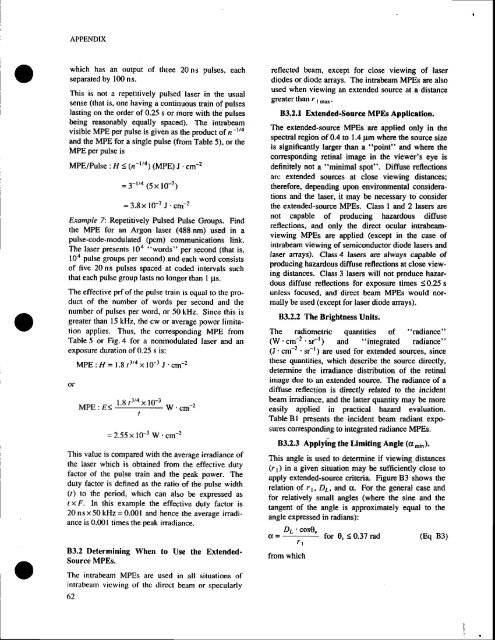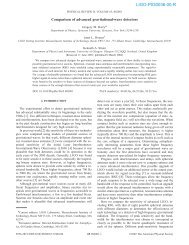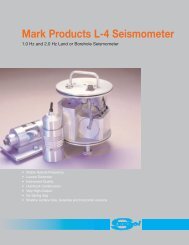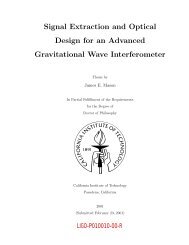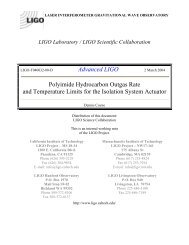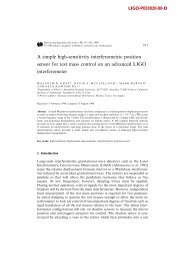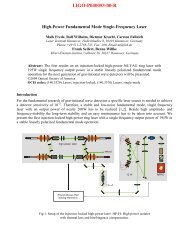for the sqfe use of lqsers - LIGO
for the sqfe use of lqsers - LIGO
for the sqfe use of lqsers - LIGO
You also want an ePaper? Increase the reach of your titles
YUMPU automatically turns print PDFs into web optimized ePapers that Google loves.
APPENDIX<br />
which has an output <strong>of</strong> three 20 ns pulses, each<br />
separated by l0O ns.<br />
This is not a repetitively pulsed laser in <strong>the</strong> usual<br />
sense (that is, one having a continuous train <strong>of</strong> pulses<br />
lasting on <strong>the</strong> order <strong>of</strong> 0.25 s or more with <strong>the</strong> pulses<br />
being reasonably equally spaced). The inaabeam<br />
visible MPE per pulse is given as <strong>the</strong> product <strong>of</strong> n-rla<br />
and <strong>the</strong> MPE <strong>for</strong> a single pulse (from Table 5), or <strong>the</strong><br />
MPE per pulse is<br />
MPE/Pulse : H < 1n-rla; lMpE; J' cm-2<br />
= 3-l/a (5 x l0-?)<br />
= 3.8x l0-7 J.cm-2<br />
Example 7: Repetitively Pulsed Pulse Groups. Find<br />
<strong>the</strong> MPE <strong>for</strong> an Argon laser (488 nm) <strong>use</strong>d in a<br />
pulse.code-modulated (pcm) communications link.<br />
The laser presents l0a "words" per second (that is,<br />
10" pulse groups per second) and each word consists<br />
<strong>of</strong> five 20 ns pulses spaced at coded intervals such<br />
that each pulse group lasts no longer than I ps.<br />
The effective prf <strong>of</strong> <strong>the</strong> pulse train is equal to <strong>the</strong> product<br />
<strong>of</strong> <strong>the</strong> number <strong>of</strong> words per second and <strong>the</strong><br />
number <strong>of</strong> pulses per word, or 50 kHz. Since this is<br />
greater than 15 kHz, <strong>the</strong> cw or average power limitation<br />
applies. Thus, <strong>the</strong> corresponding MPE from<br />
Table 5 or Fig.4 <strong>for</strong> a nonmodulated laser and an<br />
exposure duration <strong>of</strong> 0.25 s is:<br />
or<br />
MPE:11 = 1.8 l3l4x10-3 J - cm-z<br />
I R,l/4 Y l n-l<br />
MPE : E( ""' ^ '" W cm-2<br />
I<br />
=2.55x10-3W.cm-2<br />
This value is compared with <strong>the</strong> average irradiance <strong>of</strong><br />
<strong>the</strong> laser which is obtained from <strong>the</strong> effective duty<br />
factor <strong>of</strong> <strong>the</strong> pulse train and <strong>the</strong> peak power. The<br />
duty factor is defined as <strong>the</strong> ratio <strong>of</strong> <strong>the</strong> pulse width<br />
(r) to <strong>the</strong> period, which can also be expressed as<br />
t x f. In this example <strong>the</strong> effective duty factor is<br />
20nsx50kHz=0.001 and hence <strong>the</strong> average irradiance<br />
is 0.001 times <strong>the</strong> peak inadiance.<br />
83.2 Determining When to Use <strong>the</strong> Extended-<br />
Source MPEs.<br />
The intrabeam MPEs are <strong>use</strong>d in all situations <strong>of</strong><br />
intrabeam viewing <strong>of</strong> thc direcl beam or specularly<br />
62<br />
rcflected beam, except <strong>for</strong> close viewing <strong>of</strong> laser<br />
diodes or diode arrays. The intrabeam MPEs are also<br />
<strong>use</strong>d when viewing an extended source at a distance<br />
greater than r I ll's .<br />
83.2.1 Extended-Source MPEs Application.<br />
The extended-source MPEs are applied only in <strong>the</strong><br />
spectral region <strong>of</strong> 0.4 to 1.4 pm where <strong>the</strong> source size<br />
is significantly larger than a "point;'and wherc <strong>the</strong><br />
conesponding retinal image in <strong>the</strong> viewer's eye is<br />
definitely not a "minimal spot". Diff<strong>use</strong> reflections<br />
arc extended sources at close viewing distances;<br />
<strong>the</strong>re<strong>for</strong>e, depending upon environmental considerations<br />
and <strong>the</strong> laser, it may be necessary to consider<br />
<strong>the</strong> extended-source MPEs. Class I and 2 lasers are<br />
not capable <strong>of</strong> producing hazardous diff<strong>use</strong><br />
reflections, and only <strong>the</strong> direct ocular inrabeamviewing<br />
MPEs arE applied (exc€pt in <strong>the</strong> case <strong>of</strong><br />
intrabeam viewing <strong>of</strong> semiconductor diode lasers and<br />
laser arrays), Class 4 lasers are always capable <strong>of</strong><br />
producing hazardous diff<strong>use</strong> reflections at close viewing<br />
distances. Class 3 lasers will not pmduce hazardous<br />
diff<strong>use</strong> reflections <strong>for</strong> exposure times


